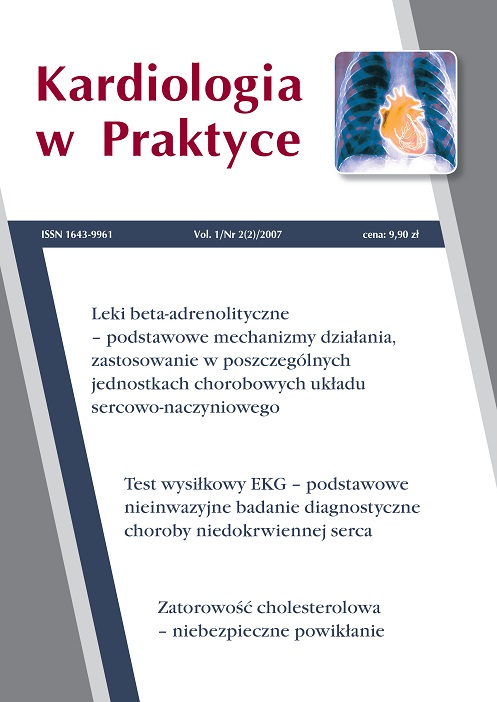Dwupłatkowa zastawka aortalna Artykuł przeglądowy
##plugins.themes.bootstrap3.article.main##
Abstrakt
Dwupłatkowa zastawka aortalna (bicuspid aortic valve – BAV) jest najczęstszą wrodzoną wadą serca u dorosłych. W populacji występuje z częstością od 1% do 2%. U większości pacjentów z dwupłatkową zastawką aortalną w ciągu życia pojawiają się powikłania wymagające leczenia operacyjnego. Lekarz praktyk często staje przed koniecznością udzielenia właściwej rady pacjentowi z BAV, a wiedza na temat patogenezy i następstw wady jest ciągle niepełna.
Pobrania
##plugins.themes.bootstrap3.article.details##

Utwór dostępny jest na licencji Creative Commons Uznanie autorstwa – Użycie niekomercyjne – Bez utworów zależnych 4.0 Międzynarodowe.
Copyright: © Medical Education sp. z o.o. This is an Open Access article distributed under the terms of the Attribution-NonCommercial 4.0 International (CC BY-NC 4.0). License (https://creativecommons.org/licenses/by-nc/4.0/), allowing third parties to copy and redistribute the material in any medium or format and to remix, transform, and build upon the material, provided the original work is properly cited and states its license.
Address reprint requests to: Medical Education, Marcin Kuźma (marcin.kuzma@mededu.pl)
Bibliografia
2. Fedak P.W., Verma S., David T.E., Leask R.L., Weisel R.D., Butany J.: Clinical and pathophysiological implications of a bicuspid aortic valve. Circulation 2002, 106 (8): 900-4.
3. Varadarajan P., Pohost G.M.: Bicuspid aortic valve is heritable. Curr Cardiol Rep 2005, 7 (1): 38.
4. Sabet H.Y., Edwards W.D., Tazelaar H.D., Daly R.C.: Congenitally bicuspid aortic valves: a surgical pathology study of 542 cases (1991 through 1996) and a literature review of 2,715 additional cases. Mayo Clin Proc 1999, 74 (1): 14-26.
5. Fedak P.W., de Sa M.P., Verma S., Nili N., Kazemian P., Butany J. et al.: Vascular matrix remodeling in patients with bicuspid aortic valve malformations: implications for aortic dilatation. J Thorac Cardiovasc Surg 2003, 126: 797-806.
6. Nataatmadja M., West M., West J., Summers K., Walker P., Nagata M., et al.: Abnormal extracellular matrix protein transport associated with increased apoptosis of vascular smooth muscle cells in marfan syndrome and bicuspid aortic valve thoracic aortic aneurysm. Circulation 2003, 108 (suppl 1): II 329-34.
7. Eisenberg L.M., Markwald R.R.: Molecular regulation of atrioventricular valvuloseptal morphogenesis. Circ Res 1995, 77: 1–6.
8. Ward C.: Clinical significance of the bicuspid aortic valve. Heart 2000, 83 (1): 81-5. Review.
9. Otto CM. Calcification of bicuspid aortic valves. Heart 2002, 88 (4): 321-2.
10. Management of Grown Up Congenital Heart Disease. European Heart Journal 2003, 24: 1035-1084.
11. Guidelines for the Management of Patients With Valvular Heart Disease. Executive Summary. Circulation 1998, 98: 1949-1984.
12. Nistri S., Sorbo M.D., Marin M., et al.: Aortic root dilatation in young men with normally functioning bicuspid aortic valve. Heart 1999, 82: 19-22.
13. Burks J.M., Illes R.W., Keating E.C. et al.: Ascending aortic aneurysm and dissection in young adults with bicuspid aortic valve: implications for echocardiographic surveillance. Clin Cardiol 1998, 21: 439-44.
14. Strandis P., Lacis R., Ozolanta I., Purina B., Ose V., Feldmane L., Kasyanov V.: Comparison of biochemical and structural properties between human aortic and pulmonary valve. Eur J Cardiothorac Surg 2004, 26(3): 634-9.
15. Roberts W.C.: The congenitally bicuspid aortic valve: a study of 85 autopsy cases. Am J Cardiol 1970, 26: 72-83.
16. Fenogilo J.J., McAlister H.A., DeCastro C.M. et al.: Congenital bicuspid aortic valve after age 20. Am J Cardiol 1977, 39: 164-69.
17. Agozzino L., DeVivo F., Falco A. et al.: Surgical pathology of the aortic valve: gross and histological findings in 1120 excised valves. Cardiovasc Pathol 1994, 3: 155-61.
